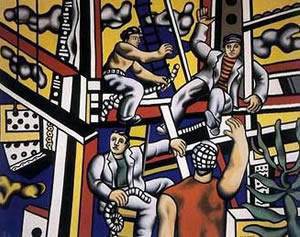
Georg Baselitz
Georg Baselitz at the Gagosian Gallery, Rome
Rome, September 23 – November 8, 2008
“In my left hand I had a photograph of The Big Night Down the Drain and pretty much stuck to the formal aspects of the painting, although of course I also knew what things had been like back then, what the mood was, what the situation was. I didn’t want to invoke that situation – in some kind of a soliloquy-like old magic, I just wanted to improve that picture, in its suffering or what it has suffered; I wanted to speed it up.”
–Georg Baselitz
]]>
Gagosian Gallery is pleased to announce an exhibition of new paintings and drawings by Georg Baselitz from his ongoing Remix series
Baselitz’s long and challenging career is marked by intense periods of activity, usually culminating in a heroic masterpiece or group of master works, followed by startling renewal and rethinking of his subject. A traditional artisan, he works in equally traditional media—painting, drawing, printmaking, and wood sculpture—-often on a monumental scale.
In the recent Remix Paintings, Baselitz has revisited the most provocative aspects of his own history. Part of an ongoing series, these new works re-examine his iconic painting The Big Night Down the Drain, 1962-63, now in the collection of the Museum Ludwig, Cologne. In this work, Baselitz depicts a faceless, masturbating boy whose identity is unclear. First exhibited in Berlin in 1963, it was confiscated by the police due to its provocative content. Although almost two decades had passed since the end of World War II, the profound personal impact of both the historical and psychological legacies of the war led him to create a startling image to reflect his sentiments that Germany was a country without direction, as it continued to struggle with its post-war economic and spiritual depression.
In his Remix Paintings, Baselitz has re-examined The Big Night Down the Drain using his own photographs of the painting to aid the process of recollection. While the original version took him several months to complete, these works are finished in a matter of hours. Against a ghostly white background, Baselitz adjusts elements of the original painting, from clearer articulations of motifs to brighter colors, as a response to his contemporary context. The skull is a new addition, perhaps alluding to the iconographic tradition of memento mori in history painting. Baselitz’s impulse to improve, clarify, and update is clearly evident, but the haunting, fleeting quality of the Remix work has also to do with a mature artist’s meditations on war, time, presence, failure and possibility.
Georg Baselitz was born in 1938 as Hans-Georg Kern in Deutschbaselitz, Saxony. His work has been exhibited extensively in solo and group exhibitions internationally since the early sixties, and was the subject of a major retrospective at the Solomon R. Guggenheim Museum in 1995, traveling to the Los Angeles County Museum, the Hirshhorn Museum and Sculpture Garden, Washington D.C., and the Nationalgalerie, Berlin. A retrospective of his work was on view at the Royal Academy of Arts, London in 2007. The Remix Paintings were recently shown at the Pinakothek der Moderne, Munich, the Albertina, Vienna and MADRE, Naples. His work is included in many public collections including the Museum Ludwig, Cologne; the Museum of Modern Art, New York; and the Tate Modern, London. Baselitz lives outside Munich, Germany and Imperia, Italy
Follow us on:


